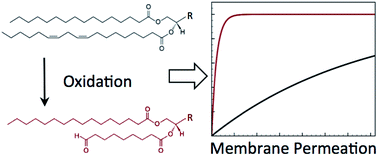Low levels of lipid oxidation radically increase the passive permeability of lipid bilayers†
Abstract
Oxidation of unsaturated lipids in cellular membranes has been shown to cause severe membrane damage and potentially cell death. The presence of oxidized lipid species in the membrane is known to cause changes in membrane properties, such as decreased fluidity. This study uses giant unilamellar vesicles (GUVs) to measure passive transport across membranes containing defined concentrations of oxidized lipid species. GUVs consisting of a saturated phospholipid, an unsaturated phospholipid, and cholesterol were used as model membranes. By replacing defined amounts of the unsaturated lipid with a corresponding oxidized product, the oxidation process could be mimicked, yielding vesicles of varying oxidized lipid concentration. Oxidized lipid concentration was varied from 0 mol% to 18 mol% of the total lipid concentration. Passive transport of PEG12-NBD, an uncharged fluorescent molecule, was measured using a microfluidic trap to capture the GUVs and spinning disk confocal microscopy (SDCM) to track the transport of a fluorescent species in the equatorial plane of each GUV. Membrane permeability was determined by fitting the resulting concentration profiles to a finite difference model of diffusion and permeation around and through the membrane. Experiments showed three permeability regimes. Without oxidation, transport was slow, with a measured permeability on the order of 1.5 × 10−6 cm s−1. At 2.5–10% oxidized species permeation was fast (1.5 × 10−5 cm s−1). Above 12.5% oxidized species, the bilayer was disrupted by the formation of pore defects. As passive transport is an important mechanism for drug delivery, understanding the relationship between oxidation and permeation could provide insight into the pharmaceutical characteristics of tissues with oxidative damage.


 Please wait while we load your content...
Please wait while we load your content...